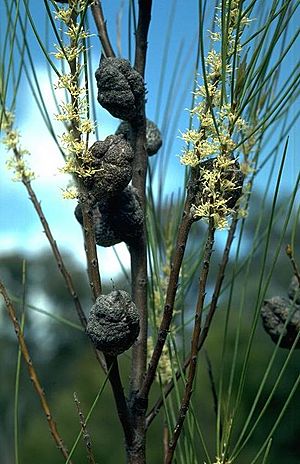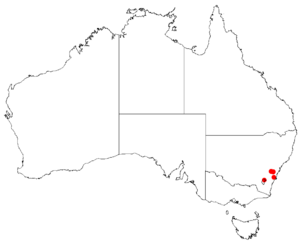Kowmung hakea facts for kids
Quick facts for kids Kowmung hakea |
|
|---|---|
 |
|
| Hakea dohertyi in the ANBG | |
| Conservation status | |
| Scientific classification | |
| Genus: |
Hakea
|
| Species: |
dohertyi
|
 |
|
| Occurrence data from AVH | |
The Kowmung hakea (scientific name: Hakea dohertyi) is a special type of shrub. It is only found in a small area of the Great Dividing Range in central New South Wales, Australia. This plant is quite rare and important to protect.
Contents
What the Kowmung Hakea Looks Like
The Kowmung hakea is an upright shrub that can grow quite tall. It usually reaches between 3 and 6 meters (about 10 to 20 feet) high. Its smaller branches are covered with soft, silky hairs when the plant is flowering.
Leaves and Flowers
The leaves of the Kowmung hakea are long and straight. They are flexible and shaped like a triangle if you cut across them. Each leaf can be 20 to 40 centimeters (about 8 to 16 inches) long and about 2 millimeters wide. They feel smooth and have three lines running along them. Each leaf ends in a sharp point.
The plant's flowers grow in small groups called an inflorescence. There are usually 4 to 6 cream-white flowers in each group. They grow where the leaves join the stem. The small stalk that holds each flower is called a pedicel. It is also cream-white and smooth. The part of the flower that collects pollen, called the style, is about 3.8 to 4 millimeters long.
Fruit
After the flowers, the Kowmung hakea produces woody, oval-shaped fruits. These fruits have a short stalk and grow at an angle from the stem. They are about 2.3 to 2.8 centimeters (about 0.9 to 1.1 inches) long. They are also about 1.2 to 2 centimeters (about 0.5 to 0.8 inches) wide. Each fruit has a small, hard beak at its end.
How it Got its Name
The Kowmung hakea was first officially described in 1999. This was done by a botanist named Laurence Haegi. He published his findings in a book called Flora of Australia.
The plant is named after Michael Doherty. He is an ecologist, which is a scientist who studies how living things interact with their environment. Michael Doherty was the person who first found this special plant.
Where the Kowmung Hakea Lives
The Kowmung hakea is found in a very small area. Most of these plants grow near the Kowmung River. This river is located inside the Kanangra-Boyd National Park. The total area where this plant grows is only about 18 square kilometers (about 7 square miles).
Its Home Environment
This plant grows in sandy or rocky soils. These soils are usually found over shale or quartzite rock. You can find it on ridges in open sclerophyll forest. A sclerophyll forest has trees and shrubs with hard, dry leaves.
Other plants that grow with the Kowmung hakea include grey gum (Eucalyptus punctata), silvertop ash (E. sieberi), and Blaxland's stringybark (E. blaxlandii). You might also see forest she-oak (Allocasuarina torulosa) and shrubs like crinkle bush (Lomatia silaifolia), (Stypandra glauca), and narrow-leaved geebung (Persoonia linearis).
Life Cycle and Bushfires
The Kowmung hakea is killed by bushfires. However, it can grow back from seeds. These seeds are stored in the plant's woody fruits, which act like a seed bank in its branches. Most of the seeds are released from these fruits after a bushfire. Some fruits might open and release seeds at other times too.
Regeneration and Threats
It takes about five years for a Kowmung hakea plant to grow big enough to produce its own seeds. If bushfires happen more often than every five years, the plants won't have enough time to make new seeds. This could cause the entire species to disappear.
Conservation Status
The Kowmung hakea is currently classified as "endangered." This means it is at a very high risk of becoming extinct in the wild. The New South Wales Office of Environment and Heritage has given it this classification.
Threats to the Plant
There are a few things that threaten the Kowmung hakea:
- Wild Goats: Wild goats eat the plants, which harms their populations.
- Rising Water Levels: The water level of Lake Burragorang could rise. This might flood areas where the Kowmung hakea grows, threatening its survival.


